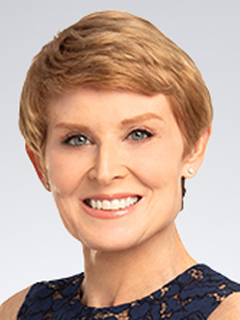
Economic Compass
Rising tide fails to lift all boats:
A jobless boom
November 4, 2025
President John F. Kennedy first coined the phrase “a rising tide lifts all boats” in a 1963 speech. The problem is that all boats do not rise with the tide. Some are not seaworthy, others are anchored in place and too many lack the means to own a boat.
That seemed an apt metaphor for where we are. The economy is powering forward, aided by a boom in AI, or arms race, as many in Washington see it, without generating many jobs.
The AI boom is not the primary driver of the weakness in the labor market to date – job gains stalled over the summer. Soaring uncertainty, cuts to the federal workforce, federal funding freezes, tariffs and curbs to immigration are all factors.
The concentration of economic gains has left the economy looking better on paper than it feels to most Americans. Consumer attitudes edged down in October on elevated concerns about inflation and jobs.
The surprise was how little the shutdown weighed on consumer attitudes. The Conference Board survey reported that only 1% of respondents mentioned it. The University of Michigan Survey noted that “There was little evidence that consumers connected the shutdown to the economy.”
Perhaps we have become numb to shutdowns. We usually recoup most of the losses. This time may be different: this is larger than other shutdowns.
The shutdown alone is shaving an estimated 0.2% from real GDP growth per week. Contractors and communities dependent upon those paychecks are collateral damage. Losses are compounding.
This edition of Economic Compass takes a closer look at the boost to growth triggered by the AI boom and how it intersects with changes in trade and immigration policy. Special attention is paid to the labor market and inflation. A recession is averted, but employment is expected to further weaken in the fourth quarter and post extremely subdued gains in 2026.
The Federal Reserve is in an untenable place: cut rates and risk stoking an asset bubble and a more persistent bout of inflation or sit idly by as employment further decouples from growth. We still expect another rate cut in December, but Fed Chairman Jay Powell was careful to caution that another cut was “not a foregone conclusion.” Views within the Fed are divided.
AI & the outlook
It’s complicated
AI-related capital investments added between 0.5% and 1.1% to growth in the first half of the year. As much as three-quarters of the 1.6% average growth during the first six months was due to AI alone.
Investment in data centers is soaring along with that for the energy and cloud services. Data centers now account for half of all commercial office space construction. (See Charts 1 & 2.) Office rents are rising in markets with a high concentration of data centers.
Many of the largest tech providers are looking to secure their own energy sources to contain costs. They are renovating old nuclear plants and at least one major player plans to launch data centers into space; those would be powered with solar panels.
Those shifts have left utilities leery of adding more capacity. The cost are large, while the tech firms could become self-sufficient, or even compete with them.
The surge in equity markets associated with AI has produced significant wealth effects. Oxford Economics estimates increases in wealth added 0.3% to consumer spending in 2024; it could match that increase in 2025.
The market capitalization of the Magnificent 7 (Mag 7) – the seven largest tech behemoths – continued to soar. The Mag 7 accounted for a staggering $20.8 trillion of the $56.9 trillion in total market cap as of October 21. (See Chart 3.)
Chart 1: AI demand powering data center and electric plants construction
$ billions, SAAR
Chart 2: Data centers nearly half of all office construction
Private construction spending, SAAR, $ Billions
Chart 3: "Magnificent seven" a growing share of S&P 500
Trillions $
A boom in real GDP
Preliminary data for the third quarter suggests that the economy surged at a 3.7% annualized pace. That is close to the 3.8% pace of the second quarter and marks the strongest six months for real GDP growth since the back half of 2023.
The fourth quarter is a bit of an unknown given the dearth of data. What we do know is that the AI boom continues. Announced AI investments will reach $380 billion in 2025 and look on track to more than match those gains in 2026.
Add rate cuts by the Fed and expansions to tax cuts and real GDP growth is forecast to rise 2.6% in 2026, up from 2.1% in 2025. Extensions to individual tax cuts in fiscal year 2025 show up as a jump in tax refunds at the start of the year; consumers treat those like windfall gains at the start of the year.
Is it a bubble?
The AI boom shares similarities with the tech bubble of the 1990s. Innovations can trigger manias. Investors chase the potential the innovations represent before knowing who will be the winners and losers.
The promise is stunning. Estimates range from a boost of 0.1% to 3% per annum in productivity growth over a decade. Reality is somewhere in between.
The gap between innovation and adoption can be long, although the rise in usage since the first large language models (LLMs) came on line is stunning. Use of the LLMs by the public outstripped the uptake of the internet and smart phones. Improvements in the technology are measured in weeks to months and go beyond the LLMs, which are a small portion of the AI landscape.
We are probably closer to the froth of 1998 than April 2000; that is when a major antitrust ruling against one of the largest tech firms provided the first pin prick. The current boom has more products in the pipeline to actually boost productivity than during the dot.com bubble. The challenge is translating those product offerings into profits, which are needed to avoid a bubble.
Most firms are financing their infrastructure investments out of cash flow. It is the recent rise in the use of debt that is raising some red flags. That could supercharge gains. Credit spreads have narrowed in recent months, making it easier for publicly traded companies to issue debt.
Startups are more at risk of a misstep, as they need venture capital to fund investments. Some of those funds are coming from larger tech companies that are funding purchases of their equipment. That has been criticized for being circular in terms of valuations.
Startup valuations are contingent on both the products they are developing and the workers they employ. AI talent is scarce and getting more difficult to tap.
Ongoing shifts in trade and immigration policy are prioritizing acquisitions over organic growth, which is more difficult due to those changes. Deal volumes are already moving up.
Planned announcements on AI investments suggest that the boom is still far from over. This is in addition to AI’s status as a strategic industry, which means more support from the government. The tech sector has been one of the largest beneficiaries of tariff waivers.
Rate cuts by the Fed will help buoy stock market valuations. The challenge will be what happens in 2026 and whether bond yields continue their descent. We are not likely to return to the ultralow interest rates of the 2010s, barring a crisis.
Other market risks. Losses in the private debt market are mounting. Those loans have higher rates than traditional bank credit. Some borrowers are paying in-kind, which means that they are leveraging to meet current debt obligations. Losses have gained the attention of the Fed.
Speculative investment is fueling other asset classes. Cryptocurrencies, stablecoins and gold have all soared to new highs this year. Precious metals are seen as a hedge against inflation and geopolitical instability, including US sanctions. That has added to their allure but can rapidly shift.
A shortfall in employment
It’s not all AI related
Monthly job gains slipped below the subdued 30,000 to 60,000 per month necessary to keep the unemployment rate steady between June and August. The unemployment rate increased to 4.3% from 4.1%.
Private sector sources suggest that the employment situation worsened in September and October. That is before accounting for losses due to the shutdown.
Net new jobs growth could slip below the half million mark in 2025, one quarter the pace of 2024. That would make 2025 the weakest year for employment since the pandemic in 2020 and the second weakest year since the financial crisis in 2009.
The demand and supply of workers have fallen in tandem, which has dampened the rise in unemployment. We expect unemployment to edge up to 4.5% by early 2026.
That increase does not account for marginalized workers. The U-6 unemployment rate is a more holistic measure of unemployment. It includes those who stopped looking for a job and workers who were forced to accept a part- instead of full-time job. That figure jumped to 8.1% in August, its highest since 2021.
The ranks of the long-term unemployed (27 weeks or longer) ballooned in August to their highest level since 2021. The long-term unemployed as a share of the workforce rose in July and August. That is unusual outside of a recession.
Curbs on foreign-born workers
Arrests by ICE agents have had a chilling effect on both legal and illegal immigration. Foreign students are studying elsewhere. They tend to pay full tuition, which enables more scholarships for native-born students.
New H-1B visas will cost $100,000, a fee that leaves them out of reach for all but the largest firms. That goes to the heart of AI talent. India has one of the largest numbers of graduates in the AI space. That ups the premium for AI talent, even as overall wage gains cool.
The offshoring of service sector jobs has fallen into the crosshairs. Two bills are currently in Congress to limit those activities. The first requires call centers to offer a domestic agent instead of someone abroad or an AI chatbot. The other levies steep taxes on firms that offshore higher skilled workers.
The tradeoff between foreign- and native-born workers is not a zero-sum game. Research on foreign- and native-born workers suggests that they are complements, not substitutes.
The surge in deportations in the 2010s revealed that the hardest hit communities experienced a rise in long-term native-born unemployment. Wages were suppressed as well; the loss of foreign-born workers disrupted entire ecosystems.
Foreign-born workers pay taxes for benefits that most cannot tap, including Social Security and Medicare. Federal deficits and debt grow in their absence.
Is AI displacing workers?
The economic research on AI’s role in the overall job market is mixed. Some show job losses; others do not.
Research suggesting that there have been job losses due to AI since 2022 shows those aged 22-25 were the hardest hit in professions most exposed to AI. The researchers found a 13% drop in entry-level computer programming, accounting and customer service jobs.
Older, more experienced workers fared better, with on-the-job knowledge protecting them from layoffs and increasing the value of their skills. That begs the question of who will replace those workers.
Work done by Revelio Labs reveals that even AI startups have smaller teams per dollar than earlier startups. That is due in part to the productivity associated with AI models.
Other studies are less conclusive. The introduction of the first LLMs in November 2022 coincided with a drop in the market cap of the Mag 7. That triggered layoffs, making it difficult to delineate correlation from causality.
Still, one cannot escape the flurry of hiring freezes and layoffs in retail, finance, technology and consulting, many of which use AI. Tariffs are exacerbating the pain, as they are squeezing profit margins and accelerating the push to leverage technology.
A boost in productivity?
Productivity growth is the difference between real GDP growth and job gains, which widened mid-year. There is little question that most firms are doing more with less: it is too early to see an economy-wide boost due to AI.
Indeed, misfires on the use of new technologies are common. One study found that 95% of firms using AI lost ground on productivity growth.
A surge in what the authors termed “workslop” undermined its benefits. That is AI-generated content that looks polished but lacks substance; correcting that work proved costly.
Firms with more than 250 workers curbed their AI adoption over the summer, according to recent Census Bureau data. That includes a lot of middle market firms, which lack the resources to create their own use cases or train their workers to use AI.
Work done by economists at MIT found a large gap between what is theoretically and economically feasible with AI tasks. They argue that AI will need to be sold as a service, so that it is easier for small and middle market firms to scale.
Worker backlash
There are strong parallels between the current fear of AI and previous predictions of a technology-induced Armageddon. The Industrial Revolution saw some of the worst worker backlash.
The Luddites were bands of weavers who destroyed machine looms in textile factories in the early 19th century. The modern labor movement was born from the harsh working conditions and inequality of the early 20th century.
Skepticism regarding AI is rising. A recent Pew Research poll revealed that half of all Americans were more concerned than excited about AI, up from 37% in 2021. That is prior to recent headlines touting a flurry of AI-related layoff announcements.
Implications for inflation
Higher prices for longer
The core personal consumption expenditure (PCE) index, which strips out food and energy, is the Fed’s favored measure. It is forecast to peak at 3.3% on a year-over-year basis in the second quarter of 2026.
Tariffs are expected to hit a peak of 15% in the second quarter of 2026. That is nearly 10% lower and almost a year later than if the administration had followed through on the April 2 announcements. The effective tariff rate is likely to taper as imports slow and mitigation efforts intensify.
Those shifts help to slow the pace of inflation in the back half of 2026. However, we do not reach the Fed’s 2% target for price stability until well into 2027.
Typically, tariffs represent a one-time bump in price levels. That presumes they are announced all at once. The sequencing of tariffs mimics the pandemic inflation and runs the risk of normalizing price hikes; we tend to get the inflation we expect.
Tax refunds are a double-edged sword. They will cushion the blow of higher prices but in so doing could spur a longer bout of inflation. Fiscal stimulus was one of many reasons that inflation flared post-pandemic.
The largest offsets are shelter costs, which are cooling. Overbuilding is pushing down apartment rents, while home values are slowing. Some of the hottest post-pandemic housing markets are experiencing price cuts.
The boost to productivity associated with AI should eventually help ameliorate inflation. We are not there yet. Everything from insurance costs to electricity bills are still rising and expected to rise further in the months to come.
Fed divisions deepen
December cut not a foregone conclusion
The Federal Open Market Committee voted to cut rates by another quarter point in October. The fed funds target range fell to 3.75% to 4.0%.
The vote was contentious. Governor Stephen Miran repeated his dissent from September, favoring a half percent cut. Kansas City Fed President Jeff Schmid voted against the cut.
Powell noted members of the Fed have “very disparate views” about the course of policy. Hawks worry that the tariff-induced inflation could stick, while doves are more focused on shoring up the labor markets.
A lack of data is another problem. Powell likened the data blackout to driving in a fog, which could force you to slow down. A former head of the Bureau of Labor Statistics in the president’s first term raised red flags about backfilling the data. We risk losing data for the CPI reports for October and November entirely, which means we cannot calculate the PCE inflation index, which the Fed targets.
We are still betting on a December rate cut, given Powell’s dovish tone. The concern will be the labor market, which looks poised to weaken prior to the end of the year. The challenge is to determine whether that weakness is more structural or cyclical in nature.
If the weakness that emerges is due to curbs in immigration and the AI boom, then rate cuts alone may not do much to correct it. Instead, policy could further stoke asset prices and spending by the most affluent households, which is spurring service sector inflation.
We expect the Fed to pause in January, with only one more cut before Powell’s term as Chairman ends in May. More aggressive cuts are expected with a change in Fed leadership. We expect the fed funds rate to end 2026 in a target range of 2.0% - 2.25%, below the 2.875% estimate of neutral.
Treasury yields fall less
Debt is starting to matter
Rising federal deficits and debt, and the risk that the Fed overstimulates, could stem the drop in bond yields. We do not expect to return to the ultralow rate environment of the 2010s anytime soon.
The yield on the 10-year Treasury note is expected to drop to 3.4% by year-end 2027. We cannot rule out a U-turn should the bond market be rattled by more debt and a persistent bout of inflation.
Bottom Line

The economic tides are shifting. Overall economic growth is decoupling from employment. That has left too many treading water instead of sailing through the choppiness in the labor market.
The challenge is to get them to shore before they slip beneath the surface. Winter is approaching, which could add a chill to stormy seas. The holiday season could leave too many marooned.
My kids are autumn babies; my son’s birthday is fast approaching. He volunteered at a food bank and asked me to donate his gift. I did, knowing that the greatest gift is opportunity, something that is lacking for too many. As you break bread this holiday season, remember that. Random acts of kindness are underappreciated. Be kind; pay it forward.
Muddy waters
Real GDP growth is expected to rise 3.7% in the third quarter given the official data we have through August. Consumer spending accelerated over the summer. The housing market remained in the doldrums with activity declining for the third consecutive quarter. Business investment remains buoyant along with inventories, which were built ahead of additional tariffs in August. Government spending rebounded as the continuing resolution ended and fiscal year 2025 funds had to be spent. The trade deficit narrowed slightly, with imports falling faster than exports.
Prospects for the fourth quarter are murky, given a dearth of official government data. Real GDP is forecast to rise only 1%, with the shutdown alone shaving 1% from growth. Gains in consumer spending are expected to slow but not collapse. The housing market is starting to bottom. Business investment is expected to remain strong, driven by AI. Government spending slows due to the shutdown. Many of those losses will be recouped in early 2026. The trade deficit further narrows.
The government shutdown is assumed to end soon, given the mounting pressure to reopen. Both sides of the aisle appear to be feeling the pressure; the pain of lost paychecks, disruptions to SNAP and targeted funding is intensifying.
The Fed moves with caution, not certitude. The Fed’s dual mandate of price stability and full employment has become a dueling mandate – both inflation and unemployment have edged up. That has heated up the debate within the Fed over which of its mandates it should prioritize. Add a lack of data and the Fed is moving with caution. We expect a narrow majority to vote for a December cut.
The Fed decided to end reductions in its balance sheet on December 1. That is a technical move by the Fed to prevent overnight market disruptions. Money market accounts are most at risk.
Economic Forecast — November 2025
Dive into our thinking:
Explore more

Bye, bye Miss American Pie
The outlook: inequality and consumer angst

KPMG Economics
A source for unbiased economic intelligence to help improve strategic decision-making.

Policy in Motion: Insights for navigating with confidence
Your resource for the latest on trade, tariff and regulatory policy changes.
Subscribe to insights from KPMG Economics
KPMG Economics distributes a wide selection of insight and analysis to help businesses make informed decisions.
Meet our team
